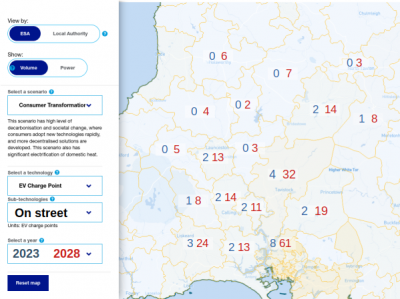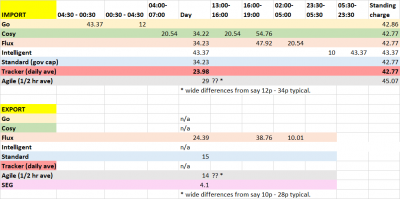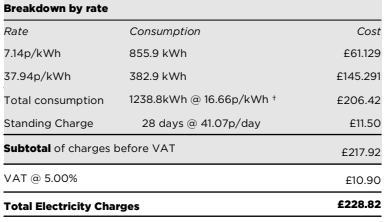@dangermousie the spreadsheet in video above is extremely detailed with a lot of historical info etc. Focus is on Cosy Octopus vs. Go with Solar
and so far he has no plan to add Tracker to comparisons. Very useful in its own way.
It still leaves the issue of trying to find best tariff to suit personal circumstances - with such a variety of tariffs! The "problem" is likely to get worse as other energy companies get creative in future
One other useful spreadsheet that picks up own data from MPAN and is focussed on Tracker vs standard rates
As well as your own exported Smart Data and returns % used during the day Vs night.
Listed Grade 2 building with large modern extension.
LG Therma V 16kw ASHP
Underfloor heating + Rads
8kw pv solar
3 x 8.2kw GivEnergy batteries
1 x GivEnergy Gen1 hybrid 5.0kw inverter
Manual changeover EPS
MG4 EV
Posted by: @tim441The "problem" is likely to get worse as other energy companies get creative in future
Tim, that was issue which prompted Ofgem to limit the number of annual fixed-price tariffs which Energy Suppliers can offer at any one time.
At a stroke, the energy comparison sites became easier to understand because each Supplier was only advertising three such tariffs.
But that's an illusion.
What the Suppliers did was to move to a set of fixed tariffs which they withdrew and replaced with others after short intervals... typically 1-month.
The comparison sites only showed those tariffs available on the day that you checked.
On the following day, Supplier-A might withdraw their "12-month fixed, July22" package and replace it with "12-month fixed, Aug22" at a different rate.
I was on an OVO tariff about 3-years ago, but also on a 2-year equipment trial.
So I knew I needed to replace my annual tariff with another one from OVO within the 7-week period for which no exit-fees would be levied.
By waiting until the last few days of that 7-weeks, I was able to secure a better price than OVO had been offering during the preceding 6 weeks.
But I could equally-well have got my fingers burnt.
Ofgem's restrictions simplify the fixed-rate tariff market at the expense of causing it to be more volatile.
There is really only one company being 'creative' with Time-of-Use (ToU) tariffs at present, and that's Octopus.
They are busy experimenting with a number of variable-rat tariffs to gain market insight whilst Ofgem hasn't yet imposed a cap on the number of ToU options which a company can offer simultaneously.
You can use the Energy-Stats UK site to follow the rises and falls of Octopus tariffs over whatever historical time-frame you choose.
Soon we will begin to see another parameter come into play which will make such an exercise more difficult for Octopus to conduct.
That's the impending strategy to have Nodal-pricing, as proposed by National Grid ESO, the Systems Operator for the Transmission Grid (400kV).
Ofgem have suggested that each Node should be defined by the Grid Supply Point (GSP) transformer which connects your house to the National Grid.
However, those areas are still pretty large. For example the SW Electricity Region in which I live, has 10 GSP's within it, and one more based just outside the Region, but supplying many homes within it.
The idea of Nodal Pricing is that the model better suits the format in which a high proportion of our electricity is derived from renewable-energy sites, widely spread across the country.
Although Nodal-Pricing based on GSPs offers a lower administrative overhead, it isn't a good match for the level of generation actually being produced from nearby solar- or wind-farms, for example.
A GSP transformer covers an area in which the weather conditions vary too widely.
It is the Bulk Supply Point transformers which provide the better alignment with local renewable-energy generation.
There 3 to 6 BSPs connected to each GSP, depending on the population density and how much electricity can be sent along the given size of overhead copper cables in that area.
Moreover pricing based on BSP supply Nodes would incentivise us consumers to use (or store) electricity generated locally, instead of a price based on measuring how much of that generation is reaching the National Grid via the GSPs.
You might well complain that Nodal Pricing layered on top of ToU Tariffs offered by a nationwide Energy Supplier, like Octopus, is just far too complex for anyone to understand, let alone to compare rival offerings. 😲
But that's the strategy which will (eventually) provide the lower-priced electricity from the greenest sources, which is what most of us end-users are seeking.
I will suggest that the way those tariff-comparison sites need to operate must change such that it is based on a dynamic map, rather than a linear table of figures.
Such maps are already being deployed by NGED for customers to better understand the dynamics of the Distribution Future Energy Strategy.
Here's map which I derived from NGED's DFES mapping-tool.
The above illustration shows the number of on-street EV charge points, which are planned between 2023 (in blue) and 2028.
But the areas shown on the map above are those in rural Devon and Cornwall which are supplied by each BSP transformer.
So the same mapping technique could be used by Comparison Websites to display electricity Nodal-pricing.
Save energy... recycle electrons!
I haven't really had a choice of which tarriff to go to when solar & batteries are installed. I want to stay with Octopus, my car isn't compatible with Intelligent, so it's with Go or Eco 7. Octopus told me that Eco 7 isn't capped, so I only have Go as an option. You can't be on Go and Outgoing at the same time, so that leaves me with Go and SEG. Have I missed something?
@dangermousie I think their Tracker tariff is consistently one of the best for import (currently waiting list to join) - ave 24.3p inc vat this year from 1st Jan to 26th Feb.
For export Outgoing Fixed at 15p kwh is pretty good. But if you can be bothered to manipulate filling & emptying batteries then Agile Outgoing maybe better as peak rates are higher.
The new Flux tariff looks interesting for period when heating is not used (say mid May to end Oct?) and producing solar and I will plan to go on that as long as I can get back of Tracker at that time.
But I don't think Flux is ideal for me all year round.
Listed Grade 2 building with large modern extension.
LG Therma V 16kw ASHP
Underfloor heating + Rads
8kw pv solar
3 x 8.2kw GivEnergy batteries
1 x GivEnergy Gen1 hybrid 5.0kw inverter
Manual changeover EPS
MG4 EV
@transparent really interesting to note! Lets hope OFGEM & energy companies both have the flexibility & nimbleness to offer rates that are fair to all. I'm sure some people will prefer to fix for peace of mind - but others will be happy to take on some "risk" with trackers, TOU etc.
Listed Grade 2 building with large modern extension.
LG Therma V 16kw ASHP
Underfloor heating + Rads
8kw pv solar
3 x 8.2kw GivEnergy batteries
1 x GivEnergy Gen1 hybrid 5.0kw inverter
Manual changeover EPS
MG4 EV
Octopus Tracker (import) rate 20th March was 21.3p/kWh inc vat for electricity - saving over 35% on standard gov capped rates of 34p+.
21st March rate is 20.3p (set day ahead at 11.00)
Listed Grade 2 building with large modern extension.
LG Therma V 16kw ASHP
Underfloor heating + Rads
8kw pv solar
3 x 8.2kw GivEnergy batteries
1 x GivEnergy Gen1 hybrid 5.0kw inverter
Manual changeover EPS
MG4 EV
latest Octopus Tracker price updates for Electricity:
Today (21st Mar) : 20.3p/kWh inc vat
Tomorrow (22nd Mar): 17.55p/kWh !!!!
Listed Grade 2 building with large modern extension.
LG Therma V 16kw ASHP
Underfloor heating + Rads
8kw pv solar
3 x 8.2kw GivEnergy batteries
1 x GivEnergy Gen1 hybrid 5.0kw inverter
Manual changeover EPS
MG4 EV
I am locked in on Go at 7.5p/kw off peak and 39p/kw peak - its insane the price arbitrage. Below is the bill I just got from Octopus for 21st of Feb to 21st of March. The difference is crazy
@batalto nice!
current tariffs are quite a bit higher of course:
Go
Night rate (00:30 - 04:30):
12p / kWh
Listed Grade 2 building with large modern extension.
LG Therma V 16kw ASHP
Underfloor heating + Rads
8kw pv solar
3 x 8.2kw GivEnergy batteries
1 x GivEnergy Gen1 hybrid 5.0kw inverter
Manual changeover EPS
MG4 EV
I will be moving to a new build with ashp in a couple of weeks. The Cosy tariff is specifically aimed at ashp owners, but how are you expected to use the tariff to get the greatest benefit?
My initial thoughts would be that the 1st cheap period is to heat water for morning showers and the second is for a repeat hot water top-up along with boosting space heating above requirement to allow gradual cool down past the expensive period.
Would be interested to know what other Cosy tariff people are doing.
Posted by: @dpcThe Cosy tariff is specifically aimed at ashp owners, but how are you expected to use the tariff to get the greatest benefit?
Do you think it being targeted at ASHP owners and named "Cosy" has been devised by a technical person or a marketing dept? 🤔
Let's look at it from Octopus' viewpoint:
- They want to gather stats on which tariff time & price points are favoured by customers
- They know that Nodal Pricing is coming, and that will skew their analysis according to the customer's location
- Ofgem has not yet decided to restrict the number of ToU tariffs which may be offered. But a Supplier can only have 3 "fixed" tariffs.
So if I were Octopus, I'd be getting statisticians to create a number of ToU tariffs from which they can glean the best possible range of market opportunities, whilst simultaneously not losing them money.
Since they are currently the only Supplier to offer such ToU tariffs nationally, that data will enable them to create pricing algorithms that are miles ahead of their competitors.
As for "Cosy", the obvious way to make it work is to use the low-cost periods to store energy.
Storing that energy as hot water (for DHW or C/H) takes up loads of space, and means that the heat pump is being switched on/off.
That lowers its COP and increases running costs.
You want the ASHP to run continuously. See comments on the topic Numerous problems...
Storing the energy in batteries takes up much less space and allows you to operate the ASHP 'off-grid'.
That means it will continue operating during a power-outage.
You can also install a large enough battery to power other devices of course.
Either way, you won't be short of suggestions and advice from other members on this Forum 🙂
But please ensure that you tell us how much 'hands on' you'd like to be.
To get the best return on your storage investment, you don't really want to be paying professional tradesmen to undertake work you can do yourself.
Save energy... recycle electrons!
-
Who's your electricity provider and what's your tariff?
1 week ago
-
EV+ Heat Pump Tarriff
4 weeks ago
-
Our journey through Octopus tariffs 2020-2025
1 month ago
-
Confusion over Octopus Tariffs
2 months ago
-
Octopus tariffs - a quick comparison
3 months ago
- 26 Forums
- 2,426 Topics
- 55.1 K Posts
- 200 Online
- 6,104 Members
Join Us!
Worth Watching
Latest Posts
-
RE: Is it normal to use power from the grid when running off the battery?
@batpred I may be asking you for more info in how you h...
By JohnnyB , 2 hours ago
-
RE: Recommended home battery inverters + regulatory matters - help requested
@johnnyb The noise of the Solis is nothing very sign...
By Batpred , 2 hours ago
-
RE: Is my Samsung gen6 outside air temp sensor missing a sheath/sleeve?
@papahuhu Yes, good information is often hard to find, ...
By Old_Scientist , 2 hours ago
-
RE: R290 and Foundation Air Bricks
Professional risk assessment (inc some common sense) ...
By ASHP-BOBBA , 2 hours ago
-

RE: The good, the bad and the not that great – my heat pump installation
@toodles ahhh no trouble yeah probably won't mess with ...
By Burtis , 3 hours ago
-
RE: Daikin Wireless Thermostat
@bash we have mostly south facing rooms which would ove...
By Judith , 3 hours ago
-

RE: Post-Traumatic Heat Pump Stress Disorder
Some more examples of those that really should be benef...
By Jeff , 5 hours ago
-
RE: Installer Fitted 9kW Instead of 11kW Heat Pump and Changed MCS Paperwork - What do I do?
I've now had an interesting email from a Complaints Res...
By MairiA , 7 hours ago
-

RE: Reliable, easy to use home battery options
Correct. LiFePO₄ cells mustn't be charged if their te...
By Transparent , 7 hours ago
-

RE: Water outage in the the south-east
Indeed!Any contamination in the well water would be tra...
By Transparent , 9 hours ago
-
RE: Solis inverters S6-EH1P: pros and cons and battery options
I hear some cases of apparent misconfiguration of inver...
By Batpred , 9 hours ago
-
Are split ASHPs with R290 refrigerant coming soon?
Question. Are there any (or likely to be in the near t...
By iotum , 11 hours ago
-

RE: Setback savings - fact or fiction?
Indeed. In many ways, a defrost is a setback, with the ...
By cathodeRay , 11 hours ago
-
RE: Heat pump not reaching flow temperature
The good news is that it leaves no excuse if it doesn't...
By JamesPa , 12 hours ago
-
RE: How to use my Hanchu battery storage for home without it feeding back into the grid?
@countryman-helmsley In that case is there a button ...
By IRMartini , 12 hours ago
-
RE: Ideal HP290 14kW ASHP - how to optimise
Great. It’s not bad is it, though I agree it may repres...
By Davesoa , 13 hours ago
-
RE: Ecodan Pump Issues… Circulation pump turns off when heat pump compressor turns off
@f1p apologies, you are absolutely correct
By Patch321 , 14 hours ago
-

RE: Samsung E101 Error Message and my ASHP Efficiency
@johnnyb amazing that the our forum is serving its purp...
By Mars , 1 day ago
-
Best option for controller upgrade? - Grant Aerona
Fairly new heat pump owner - Grant Aerona 3 10kw - and ...
By Topher , 1 day ago
-

Just a brief update to keep things transparent. Secti...
By DREI , 1 day ago









